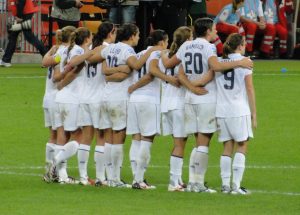For my family and I, that means a month of watching soccer together and cheering for our teams. Once again, sports bring us together! I started to follow soccer as a child with my grandmother who was an avid fan and now I share this with my two daughters. Both are athletes and have benefited tremendously from their participation in sports. They have celebrated victories with their teammates, powered through defeats, attended countless trainings and are developing into confident and strong young women. I can observe first hand the positive impact that playing sports has on girls. Each time I attend an awards ceremony, I am amazed at the number of girls who are not only recognized for their athletic performances but also for their academic achievements. As a parent, I was dreading the high school years, but I now look at my oldest daughter’s friends, the majority of whom are either field hockey or soccer teammates, and feel that she has surrounded herself with an amazing network. The experience of our girls is not unique. Research has touted the benefits of sports in reducing the risk of obesity and increasing self-esteem. Studies have shown that girls who play sports are less likely to use drugs or smoke, and that there is a lower risk of teen pregnancy among athletes. Girls involved in sports are also overall less likely to drop out of school. The list goes on and the lessons athletes learn on the field carry benefits that will enrich their lives well beyond the high school years.
My husband and I feel privileged to be able to offer these opportunities to our children but realize that not all girls and women have had the same experience. June 23rd marked the 42nd anniversary of Title IX. After Title IX was voted into law in 1972, over forty years ago, girls’ involvement in high school sports increased dramatically from 295,000 in 1972 to over 3.2 million in 2012-13, according to National Federation of State High School Associations, and girls are becoming involved in sports at an earlier age. However, there is still a gender and race disparity. In 2013, girls’ participation in high school sports remains lower than that of boys in 1972. That is a participation gap that spans four decades! According to the Women’s Sports Foundation, only 64% of African-American and Hispanic girls play sports while 76% of Caucasian girls do. Of all the many benefits around sports participation, the direct link between sports and education is critical. Beyond the obvious sports scholarships, research shows that student athletes are more likely to graduate, an important fact when one takes into account that while overall, 24% of girls fail to graduate on time with a diploma, that number increases to 35% for African American and 34% for Hispanic young women. Not surprisingly, African American and Hispanic girls who have less participation in sports during their teenage years are at a greater risk to drop out.
While we can certainly celebrate the progress that has been made since 1972, there is still some work ahead of us. All girls deserve to experience the joys and lessons of sports. Let’s continue to debunk the myths that still exist around Title IX and encourage all to play sports. The U.S. Men’s National Team might be out of the World Cup this year, but in my house, we’re just as excited to see the U.S. Women’s National Team tear it up at the Women’s World Cup in 2015!
If you want to cheer on DC’s own women’s soccer team, join us on July 30th at the Washington Spirit’s game against FC Kansas City, where the team will be highlighting local non-profits, including Washington Area Women’s Foundation. For discounted tickets to this game (and the rest of this season’s games), click here.



